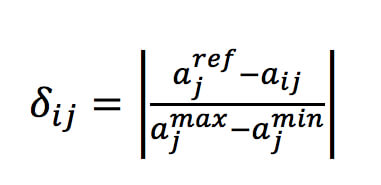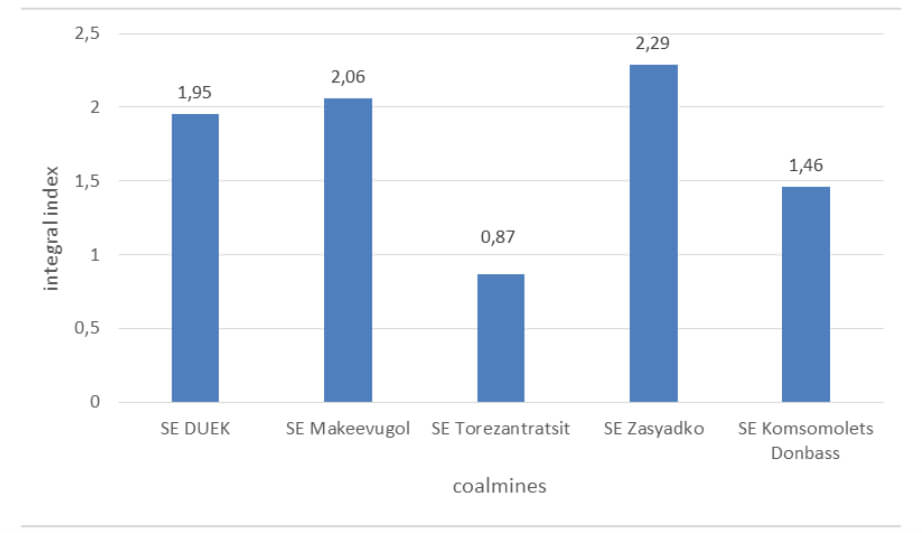Abstract
Content
Introduction
Today, investment attractiveness plays an important role in the activation of investment processes. The high level of investment attractiveness guarantees a stable flow of investments into the country, additional revenues to the state budget, as well as the improvement of the social environment in the country. The issue of assessing the investment opportunities of the enterprise is becoming increasingly relevant. Because, on the one hand - it is the basis for the development of its investment strategy, and on the other-the ability to detect shortcomings in the activities of the enterprise, to provide measures to eliminate them and improve the conditions for attracting investment resources.
The aim of the study is to analyze the main approaches and assess the investment attractiveness of the coal mining enterprise.
The object of the study is the investment attractiveness of coal mining enterprises.
The subject of the study is theoretical approaches and practical methods of assessing the investment attractiveness of coal mining enterprises.
Research methods: analysis of literary sources, method of induction and deduction, comparative and descriptive analyses.
The scientific novelty of the obtained results lies in the formation of ideas about the assessment of investment attractiveness of an industrial enterprise and the development of methodological tools for the integrated assessment of its level.
1. The essence of the concept investment attractiveness of the enterprise
One of the most important aspects of the functioning of organizations is investment activity. To attract investment resources, an enterprise must meet a number of characteristics. Formation of investment attractiveness of the enterprise is necessary for: ensuring competitiveness of production and improvement of its quality; structural adjustment of production; creation of necessary raw material base for effective functioning of the enterprises; updating of fixed assets; improving the technical level of labor and production.
Many scientific works are devoted to the study of the problem of investment attractiveness. Despite the exceptional attention of researchers to this topic, scientists have not developed a universal definition of investment attractiveness yet, which would meet the needs of both theory and practice. For Example, Nosova O. V., Rusak N. A. determine the investment attractiveness as a balanced system of integrated and complex indicators of the feasibility of investing money in a business entity [1, 2]. Dontsov S. S. notes that for investor it is the reliability of profit when investing money in securities of the enterprise [3]. As a result of the analysis, we can say that, in general, investment attractiveness is considered as an integrated assessment of the enterprise as an object of investment, which characterizes the production potential, financial condition, management and interests of the subjects of the investment process. At the same time, it is necessary to focus on the purpose of investment. Thus, foreign researchers R. N. Holt and S. B. Barnes [4] believe that investments are aimed at achieving profit and income as the most important criteria for the effectiveness of operational, financial and investment activities of economic entities of the market economy.
Also, it is necessary to take into account the following essential characteristics of the concept investment attractiveness of the enterprise
:
1. The presence of a double effect.
The investment process involves the implementation of subject-object relations on the formation, redistribution and consumption of capital. The customer of the assessment of investment attractiveness can be both the subject and the object of investment. A characteristic feature of successful investment is the mandatory presence of a double effect: positive consequences for both the subject of investment (investor) and the object (recipient).
2. Taking into account the requirements of potential investors.
The level of investment attractiveness increases due to the rapid achievement of a consensus of interests between the subjects of the investment process. Therefore, definition should be taking into account the requirements of potential investors, the provision of which is an important condition for a high image assessment of the enterprise.
3. Cooperation with potential investors.
Often, the assessment of the investment attractiveness of the enterprise is based on subjective judgments. Therefore, at the stage of formation of mechanisms that ensure transparency of activities, the management of investment attractiveness is reduced to regulating the investor's access. When the mechanisms are formed, the management of investment attractiveness is reduced to the regulation of the investor's ability to influence strategic decision-making and the formation of financial policy. For this reason, we can agree with the position of Popov M. N. and Bocharova M. P. that at first glance, objective concept of investment attractiveness becomes subjective and manageable
[5]
4. The symbiosis of financial, economic and psychological assessments of the company will help owners and investors to have a holistic view of the company.
2. Methodological approaches to assessing the investment attractiveness of the enterprise
Analyzing the existing approaches to assesse the investment attractiveness of the enterprise, we can identify the following areas [6]:

Picture 1 – The approaches to assess the investment appeal of enterprise
(анимация: 9 кадров, 8 циклов повторения, 52 килобайта)
The most simple and easy to use are the methods based on the analysis of the financial indicators of the enterprise. The prevalence of this approach is explained by the ease of use of this analytical tool, the ability to comprehensively assess the current financial position of the enterprise. This approach does not require the collection of additional information that is not filed in the financial statements of the enterprise. However, such assessment of the enterprise is not sufficient, because of both satisfactory and unsatisfactory financial condition of the business entity does not reflect the prospects for development and reserves to improve performance (Melay E. A. Approaches to assessing the investment attractiveness of the organization: comparative analysis [7].
Regarding the market-based approach to assesse the investment attractiveness of the enterprise, it should be noted that in addition to the fact that these methods are intended only for enterprises of joint-stock ownership, most of them can not be applied to domestic enterprises, because the securities market does not perform an investment function. In most cases, the ownership of shares is not accompanied by an increase in dividends and stable profits. Enterprises cannot effectively use the instruments of the securities market, as the latter is inefficient and ineffective.
When applying the cost-based approach to assesse the investment attractiveness of the enterprise, the question arises, which indicators to use and how. Their set depends on the type of investor and his motivation, as well as the horizont of the evaluation.
An integrated approach comprehensively assess the investment attractiveness of enterprises, in a certain way taking into account the prospects for the development of the object of investment [8].
3. Integrated assessment of investment attractiveness of coal mining enterprises
With regard to the coal enterprises it is reasonable to use integrated assessment of investment appeal [9]. Firstly, we need to identify indicators that impact on investment attractiveness of coal mines. All indicators can be divided into two groups: mining engineering and economic. The mining engineering indicators have the greatest impact on the integrated assessment. The importance of this group is 0.7. A set of economic indicators characterizes the economic activity of the coal enterprises from the market point of view. These indicators are characterized as economic activity of the enterprise. The importance of this group is 0.3.
These indicators provide a comprehensive analysis of a mine. The first thing that needs to be done is to form a matrix A of dimension n × m:

where aij – is j-th index value for i-th object; n – the number of mines; m – the number of indicators taken into account. Each row {ai} corresponding to the same set of indicators for the various coal enterprises. Initial data for the calculation of the integral index is the value matrix of indices of all the mines.
Initial data for the calculation of the integral index is the value matrix of indices of all the mines.
Secondly, we need to determine a reference organization. For this purpose, in each column of the matrix A optimal value is selected (minimum or maximum index):
– if improvement value of the index shows a positive trend, a reference index will be considered with a maximum value;
– if improvement value of the index indicates the negative trends, the reference index will be considered with a minimum value. Due to the fact that most of the indicators have different dimensions and are not compatible, there is a necessity to bring them to the relatively dimensionless form (formula 2):

where ajref, aij, ajmax, ajmin – the reference, the actual, maximum and minimum values of mines indicators correspondently.
Initial matrix is replaced by a matrix of relative deviations of the same dimension, and further calculations are carried out on this matrix:
Thirdly, it is necessary to reduce relative deviations from a reference of all factors for every mine to get integral index Ki.
The principle of integral index is: the less the value of the integral index is, the better enterprise matches version of the reference. The value of integral index will reflect level of its declining and estrangement from the reference. It is important to emphasize that the assessment objectivity is associated with the inclusion of different importance of individual indicators within the group. Without taking into account the importance of particular indicators, it is impossible to solve the problem of allocation of the most investment-appeal enterprise.
In the work Kalacheva et.al (2016) the importance level of the mining engineering and economic indicators of the 20-point scale is justified and numerically expressed. The indicators level and group importance have been determined by the experts. Indicators of different importance rate are defined as follows:
Integral index of investment appeal is calculated as follows:

where φj – the importance of the index in the group;
φср – the average value of importance of all parameters;
m – the number of indicators;
φj/φср – the indicators importance level of j-th figure in the group.
Thus, the integral index is calculated separately for each group of mining engineering and economic indicators:Km j, Kec j
.
At the next stage the total integral indicator is calculated individually for each mine:

where Km i, Kec i – integral assessment for each mining engineering and economic indicators correspondently;
λm, λec – the relative importance of the corresponding groups of indicators.
Five state coal enterprises of the Donetsk people republic were analyzed according to this method. Calculation results can be presented graphically as at picture 2.

Picture 2 - The level of investment attractiveness of the coal-mining enterprises
Conclusion
Investment attractiveness of the enterprise is considered as a generalized characteristic of the advantages and disadvantages of the object of investment, which allows potential investors to draw conclusions about the need and expediency of investing in this object.
The main approaches to the analysis of IAE are: the approach based on the analysis of financial indicators, market-based, cost-based and integrated approaches.
However, for the enterprises of the coal mining industry it is most expedient to use the integrated assessment of investment attractiveness, as it allows to carry out a comprehensive analysis of the business entity. Thus, this article presents a method for calculating the integral indicator of the IAE assessment in relation to coal mines.
The next step in the research is development possible variants of investment projects on increasing production capacity of a mine to assess economic efficiency in the mines of different investment appeal degrees.
References
- Носова, О. В. Инвестиционная привлекательность предприятия / О. В. Носова // стратегические приоритеты, 2013. – № 44. – С. 120–125.
- Русак, Н. А. Оценка инвестиционной привлекательности предприятия / Н. А. Русак // инвестиции: практика и опыт, 2014. – №15. – С. 22–24.
- Донцов, С. С. Оценка инвестиционной привлекательности предприятия посредством анализа надежности его ценных бумаг /С. С. Донцов. – Владивосток : Фин-М, – 2009. – 167с.
- Холт, Р. Н. Планирование инвестиций : Пер. с англ. / Роберт Н. Холт, Сет Б. Барнес. – М. : Акад. нар. хоз-ва : Дело, 2014. – 116с.
- Попов, М. Н. Основные подходы к оценке инвестиционной привлекательности российских регионов: преимущества и недостатки [Электронный ресурс]. Режим доступа: https://moluch.ru/conf...
- Пилипенко, О. И. Анализ инвестиционной привлекательности: обзор методик / О. И. Пилипенко // [Электронный ресурс] : сайт : сборник научных трудов. – Киев, 2016. – Режим доступа: http://pbo.ztu.edu.ua/article...
- Мелай, Е. А. Подходы к оценке инвестиционной привлекательности организации: сравнительный анализ [Электронный ресурс]. Режим доступа: https://cyberleninka.ru/article...
- Кохно, П. А. Методика оценки инвестиционной привлекательности предприятий [Электронный ресурс]. Режим доступа: http://vernadsky.tstu.ru/pdf...
- Майдуков, Г. Л. Особенности оценки угольных шахт как объектов инвестирования [Электронный ресурс]. Режим доступа: http://dspace.nbuv.gov.ua/bitstream...
- Черный, И. Инвестиционная привлекательность предприятия и факторы, которые ее определяют / И. Черный // [Электронный ресурс] : сайт : статьи, отчеты. – Москва, 2016. – Режим доступа: http://elartu.tntu.edu.ua/bitstream...









